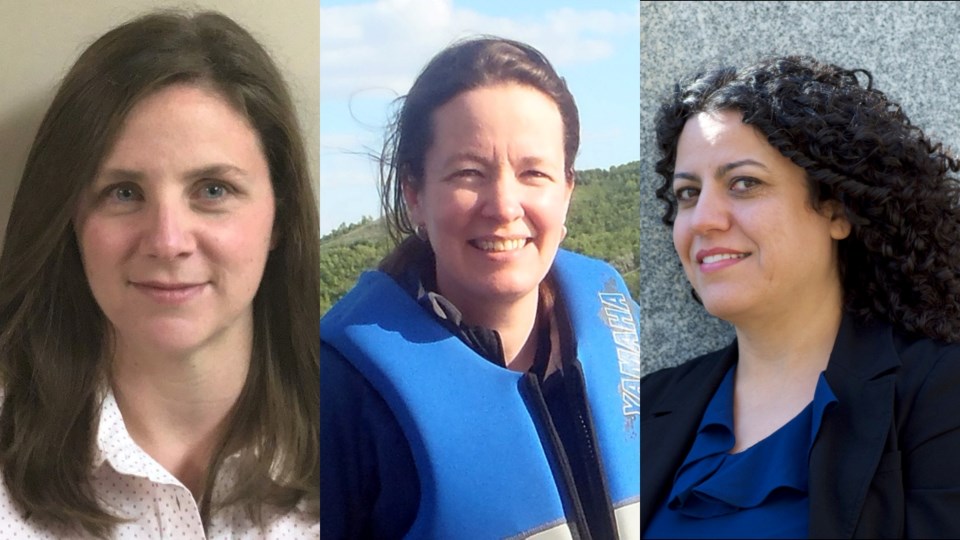SASKATOON – Three University of Saskatchewan (USask) researchers have been awarded $430,000 in total by the Canada Foundation for Innovation (CFI) to help purchase cutting-edge equipment that will advance research aimed at reducing environmental and health-care burdens for Canadians.
The new equipment will help Dr. Helen Baulch (PhD) examine specifics of how extreme Prairie weather and seasonality affects water security in a region that has long fought to maintain water quality. Dr. Asmahan AbuArish (PhD) will work to uncover the key molecular players behind cases of inflammatory pulmonary disease, using fluorescence imaging and molecular biophysics expertise. Dr. Jenny-Lee Thomassin (PhD) will use specialized technology to better understand bacteria proliferation in complex real-world environments.
“We are grateful for this timely investment by CFI that helps equip our researchers with the state-of-the-art tools they need to drive innovation and unleash discovery in the globally critical areas of water quality and One Health,” said USask Vice-President Research Baljit Singh.
The funding is provided through CFI’s John R. Evans Leaders Fund (JELF), which helps institutions attract and retain outstanding researchers by providing up to 40 per cent of the cost of academic research infrastructure. The remaining funds are solicited from other public and private sources.
Infections caused by antimicrobial- and antibiotic-resistant bacteria represent one of the biggest emerging health challenges in Canada and around the world. To understand how bacteria interact with their environment, experimental conditions that mimic various environments and provide live imaging are needed. A major challenge researchers face in the laboratory is mimicking these complex real-life environments.
JELF funding of $130,000 will help Thomassin, an assistant professor of biochemistry, microbiology and immunology in USask’s College of Medicine, bring specialized technology to Saskatchewan that will help address critical gaps in knowledge related to the chain of events that lead to bacterial infections.
“This specialized equipment — called a microfluidics system — will help address fundamental research questions, incorporating many aspects of the dynamic and changing environments found in nature,” said Thomassin. “It can mimic real-world environments, imitating the different parts of our bodies or surfaces found in hospitals, and is integral to developing highly relevant phenotyping, colonization, and infection models.”
The new cutting-edge technology will enable Thomassin to advance her research to identify and dissect the arsenal of tools bacteria use in real-world conditions. This instrumentation will also be able to test if disinfectants or newly developed antimicrobials are able to treat dangerous bacteria — a key goal in the field and something that has an impact on Canadians’ daily lives and health.
A major burden on both affected individuals and the health care system, hyperinflammatory pulmonary diseases are among a group of respiratory conditions that ranks as the fifth most common cause of death in Canada.
The airway cells of individuals with these diseases do not correctly regulate inflammation levels, leading to difficulty breathing and other symptoms that can be dangerous and potentially fatal. The specific mechanisms by which airway cells regulate inflammation are not fully understood.
With JELF funding of $175,000, AbuArish’s research team plans to acquire a super-resolution scanning confocal microscope, which enables advanced molecular biophysics analyses. There are no other microscopes of that type in Saskatchewan and few in Canada. This highly sensitive and fast imaging equipment will allow the team to examine the cells that make up the airways at a molecular level to determine the molecules at play as airways regulate inflammation in real time.
AbuArish, an assistant professor of anatomy, physiology, and pharmacology in USask’s College of Medicine, specifically plans to uncover the origins of inflammation malfunction by investigating the behaviour of essential inflammatory proteins under different health and disease conditions.
“Understanding inflammation dysregulation in pulmonary diseases by uncovering the molecular players will pave the way for scientific and pharmaceutical communities to design more effective therapies,” said AbuArish.
One of the biggest challenges facing the Prairies is the declining water supply, coupled with diminishing water quality, said Baulch, a professor in USask’s School of Environment and Sustainability.
The Prairies are naturally considered to be drylands, and therefore water insecurity is a risk, she said. But with extreme wet and dry periods — seen more often with climate change — rivers and lakes that serve as water reservoirs can change rapidly.
“Automated monitoring and sensor technology is required to understand these extremes and how they affect water security,” said Baulch. “For example, we need to be able to understand the transition from winter ice cover to open water conditions that often bring early algae blooms in spring. But it’s a time period we cannot safely sample water without sensors.”
JELF support of $125,000 will help Baulch and her colleagues, Dr. Tim Jardine (PhD) and Dr. Colin Whitfield (PhD), acquire innovative technology that can assist their research group with monitoring and capturing the effects of extreme weather on Prairie aquatic ecosystems.
The new sensing technology will also capture how rates of greenhouse gas emissions from water bodies change over days and seasons, another important contribution to understanding the role aquatic ecosystems play in global GHG emissions.
— Submitted by USask media relations





